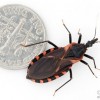 The eastern bloodsucking conenose belongs to the subfamily Triatominae, known as the kissing bugs. Despite their affectionate vernacular name, they are particularly threatening “assassin bugs” who require blood meals to survive and reproduce. They are a known vector of American trypanosomiasis (or Chagas Disease) in South America, a debilitating illness caused by the parasite Trypanosoma cruzi. This disease is a problem in South and Central America and has been detected in the United States, but has not been found in Florida. This 4-page fact sheet was written by John L. Capinera, and published by the UF Department of Entomology and Nematology, November 2013.
The eastern bloodsucking conenose belongs to the subfamily Triatominae, known as the kissing bugs. Despite their affectionate vernacular name, they are particularly threatening “assassin bugs” who require blood meals to survive and reproduce. They are a known vector of American trypanosomiasis (or Chagas Disease) in South America, a debilitating illness caused by the parasite Trypanosoma cruzi. This disease is a problem in South and Central America and has been detected in the United States, but has not been found in Florida. This 4-page fact sheet was written by John L. Capinera, and published by the UF Department of Entomology and Nematology, November 2013.
http://edis.ifas.ufl.edu/in1018
Tag: Reduviidae
Milkweed Assassin Bug (Suggested Common Name) Zelus longipes Linnaeus (Insecta: Hemiptera: Reduviidae) (EENY489/IN883)
Commonly called the milkweed assassin bug, because it closely resembles the milkweed bug, it is also known as the longlegged assassin bug and the Zelus assassin bug. Members of the genus Zelus belong to the subfamily Harpactorinae and are diurnal in nature. They are generalist predators feeding on a wide range of soft-bodied prey in garden and fields, such as mosquitoes, flies, earthworms, cucumber beetles, and caterpillars (fall armyworm, rootworm, etc.) Learn more in this 7-page fact sheet written by Megha Kalsi and Dakshina R. Seal, and published by the UF Department of Entomology and Nematology Department, February 2011.
http://edis.ifas.ufl.edu/in883